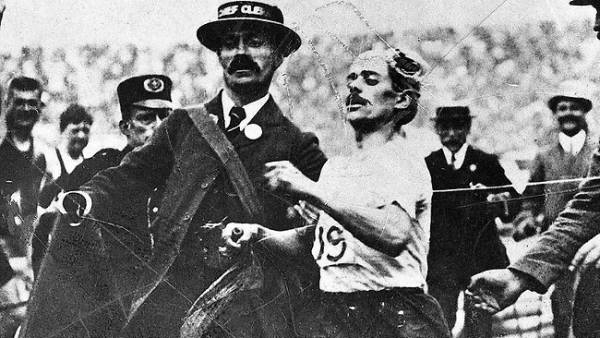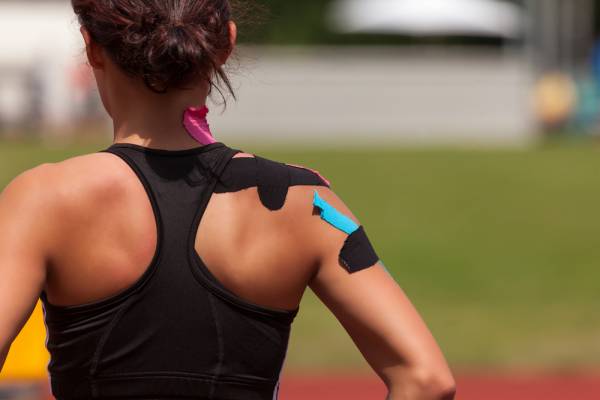In my coaching and playing, I’ve taped a lot of ankles. Mostly my own and a few kids I’ve coached, but I’ve taped those same ankles a lot. I’ve taped them enough to be incredibly good at it.
If your tape wrinkles during application, it’s going to create a pressure point that gets progressively worse throughout wearing; Eventually it becomes painful and a compensatory motor pattern emerges. The same can be said for taping just about any body part, and there are a ton of ways you can tape someone that will decrease their performance.
But can taping actually increase performance?
RELATED: Effects of Ankle Taping on Performance and Safety
Types of Taping and Types of Outcome
Probably not with the (usually) white tape that you apply after pre-wrap – the stuff you’ll find in the medkit of your kindly high-school athletic trainer. I use this stuff all the time.
But that’s not the only kind of tape I have in my kit. There’s also a type of self-adherent tape, which only sticks to itself and not to skin or hair (it’s normally used on horses, rugby players, and other animals). That’s good for taping a head (normally to cover a bleeding wound) or any area that’s inappropriate for pre-wrap plus tape. These kinds of tape don’t improve performance above baseline (although there’s a lot to be said for limiting the amount of blood you allow to escape from your head).
With taping, we’re talking about a desired outcome that falls into three categories:
- Pain Relief – Something hurts and you tape the area to make it hurt less
- Use – A part of you is injured and you plan on using it anyway
- Performance – Nothing hurts and you’re trying to get an ergogenic effect
Scenario number one is usually covered with number two, in varying percentages. This is why people have used athletic tape for the past fifty years. Now there’s kinesiology tape – this is the stuff that everyone at the 2014 CrossFit Games was wearing. By everyone, I mean mostly the people not competing.
“The rigidity has a stiffening effect of your own muscle around the ankle, and that, kids, is how tape actually works.”
I got stuck on a line behind a couple of obvious firebreathers discussing the merits of the tape, and although their discussion approached poetry-slam levels of pretentiousness, it made me want to investigate further. Does this stuff actually work?
How Taping Actually Works
When I tape an ankle injury with the white stuff, I know exactly how it’s working. When you first tape an ankle, the restrictive nature of the tape will limit movement and keep the injury from extending past its injured range of motion. The tape does this primarily through proprioceptive awareness. Or rather, your body does this because it is made aware of its limited mobility through feeling the tape.
As for the tape itself, by the end of a typical football game (or whatever), it’s sustained so many micro-tears that it’s not providing any stability on its own – but because your nervous system senses its presence, it still has an effect (though obviously less than when it was first applied). The rigidity has a stiffening effect of your own muscle around the ankle, and that, kids, is how tape actually works (c’mon, you didn’t think that a piece of cloth tape would be strong enough to hold your joint in place, right?).
RELATED: The Science Behind Why “I Think I Can” Actually Works
That’s what tape does – alters your muscle recruitment pattern through increased proprioception and CNS awareness to provide more stability to the injured area. So if we can alter the way our muscles fire with regular white tape, it’s not a huge leap to think we can figure out a way to get some performance gains out of the stuff.
Look at the Science Behind the Practice
Still, we’ve seen tons of top-flight athletes using Kinesiology Tape, and that’s more than enough evidence for it to start trending among weekend warriors. But just because an Olympic gold medalist uses something, doesn’t mean it actually works. Since I used up the Breathe Right analogy in my last article, I’m going to use this one:

See the dude pictured above? He’s running a marathon in the 1908 Olympics, and he crossed the finish line first. The thing he’s holding in his right hand is a wedge of cork, which runners believed would allow you to flex your hand muscles while you ran, without straining them, and somehow this would make you faster and able to concentrate harder.
He had also just drunk a bit of strychnine (yes, the poison). Again, thinking it would help him run faster. Again, this is why I don’t trust athletes 100% when it comes to the things they do and believe will help them perform better. So I generally look to the science behind the practice.
What the Studies Say About Taping for Performance
What I’d really like to tell you at this point, is that I found hundreds of studies where people strapped on a bunch of kinesiology tape and started crushing their PRs and that it was all rigorously documented by scientists, in studies not funded by the companies who manufacture the tape. That kind of evidence doesn’t exist.
“The findings would seem to indicate that the positive effects some claim to get from using kinesiology tape may be a placebo effect.”
Very little has been written on the topic of taping for increased performance. Data is so scarce that I’d be willing to accept a less than robust body of work. I’d be happy with one great piece and another couple good works (think Chuck Palahniuk), or one great piece and maybe one other decent piece (think Cormac McCarthy). I’d even be happy with a single widely regarded work (J.D. Salinger, God, etc.).
But here’s what I got instead:
- …after wearing [kinesiology tape] for an extended amount of time, proprioceptive deficits were improved1
- …[kinesiology tape] decreases the rate of medial loading in MTSS [medial tibial stress syndrome] patients…2
- Facilitatory taping… enhanced the activity of the underlying muscle… inhibitory taping application did not produce significant results3
- …kinesiology tape may have limited potential to reduce pain in individuals with musculoskeletal injury; however, depending on the conditions, the reduction in pain may not be clinically meaningful4
- … application of kinesiology tape decreases fatigue-induced joint repositioning error5
- …tactile stimulation in the form of Kinesiology tape inhibits the decline of both strength and electromyography6
- …tape may improve static restraint in the ankle joint without altering peak motion or dynamic postural control7
- …for a majority there were no statistically significant differences found in both the study group and control group8
- …greater mean muscle activity was found when ankles were taped with nonelastic tape compared to no tape…[kinesiology] Tape had no significant effect on mean or maximum muscle activity…9
I’m sort of convinced that kinesiology tape can be useful for performance, because there were some encouraging results in a few studies, but I doubt most people are using it correctly. As usual, there’s a fine line between being a trend jumper and being on the cutting edge. Sure, you were eating paleo ten years ago and got your first pair of minimalist running shoes in 2006, but there’s a Soloflex, a Thighmaster, and a Shakeweight in your basement.

Perhaps the best study I reviewed was one where thirty healthy participants performed isokinetic testing under three taping conditions: true facilitative kinesiology tape, sham tape, and no tape. Participants were blindfolded for the tests, so they didn’t know which tape was being applied. There were no differences in their peak torque, total work, or time to peak torque in any of the three taping conditions. The findings would seem to indicate that the positive effects some claim to get from using kinesiology tape may be a placebo effect.
RELATED: Kinesio Taping: Does it Work?
Summary
Is that the worst thing in the world? If your bench press goes up by twenty pounds, do you care if it was a placebo gain? I don’t. Twenty pounds is twenty pounds. But here, the science isn’t telling us we’ll put twenty pounds on our bench press. It’s telling us that there are potential structural and neurological effects to be had from the tape, but more research is clearly needed.
I have no problem with athletes using whatever they think is going to help their performance, so if you like this stuff, by all means, use it. It’s not going to hurt your performance. I’m just not totally convinced that it’s going to help you, either.
References:
1. Simon J. et al. “The effect of kinesio tape on force sense in people with functional ankle instability.” Clin J Sport Med. 2014 Jul;24(4):289-94. doi: 10.1097/JSM.0000000000000030.
2. Griebert MC. et al. “Lower-leg Kinesio tape reduces rate of loading in participants with medial tibial stress syndrome.” Phys Ther Sport. 2014 Jan 29. pii: S1466-853X(14)00002-9. doi: 10.1016/j.ptsp.2014.01.001. [Epub ahead of print]
3. Gusella, A. et al. “Kinesiologic taping and muscular activity: a myofascial hypothesis and a randomised, blinded trial on healthy individuals.” J Bodyw Mov Ther. 2014 Jul;18(3):405-11. doi: 10.1016/j.jbmt.2013.11.007. Epub 2013 Nov 8.
4. Montalvo, AM., et al. “Effect of kinesiology taping on pain in individuals with musculoskeletal injuries: systematic review and meta-analysis.”Phys Sportsmed. 2014 May;42(2):48-57. doi: 10.3810/psm.2014.05.2057.
5. Konishi Y. “Tactile stimulation with kinesiology tape alleviates muscle weakness attributable to attenuation of Ia afferents.” Sci Med Sport. 2013 Jan;16(1):45-8. doi: 10.1016/j.jsams.2012.04.007. Epub 2012 Jun 6.
6. Fayson SD., et al. “The effects of ankle Kinesio taping on ankle stiffness and dynamic balance.” Res Sports Med. 2013;21(3):204-16. doi: 10.1080/15438627.2013.792083.13.
7. Briem, K. “Effects of Kinesio Tape Compared With Nonelastic Sports Tape and the Untaped Ankle During a Sudden Inversion Perturbation in Male Athletes.” Journal of Orthopaedic & Sports Physical Therapy. Volume 41, Issue 5.
8. Ptak A., et al. “The influence of short-term kinesiology taping on force-velocity parameters of the rectus abdominis muscle.” J Back Musculoskelet Rehabil. 2013;26(3):291-7. doi: 10.3233/BMR-130382.
9. Han, JT., et al. “Effects of kinesiology taping on repositioning error of the knee joint after quadriceps muscle fatigue.” Phys Ther Sci. 2014 Jun;26(6):921-3. doi: 10.1589/jpts.26.921.
10. Poona, K.Y., et al.”Kinesiology tape does not facilitate muscle performance: A deceptive controlled trial.” Manual Therapy. DOI: 10.1016/j.math.2014.07.013. Epub 2014 Jun 19
Photos 1 & 3 courtesy of Shutterstock.






